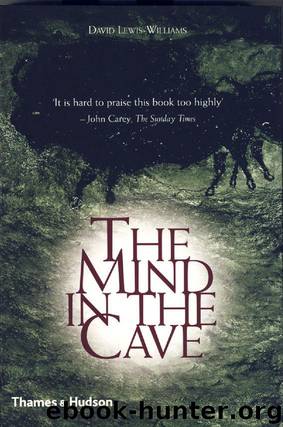The Mind in the Cave: Consciousness and the Origins of Art by Lewis-Williams David

Author:Lewis-Williams, David [Lewis-Williams, David]
Language: eng
Format: azw3
Tags: history, art history, archaeology, anthropology, prehistory, psychology, religion, sociology, history, art history, archaeology, anthropology, prehistory, psychology, religion, sociology
ISBN: 9780500770306
Publisher: Thames & Hudson
Published: 2004-04-16T16:00:00+00:00
42 The killing of a bighorn sheep was associated with rain-making. When a shaman killed a sheep, he was, in effect, killing himself.
In this list, Whitley gathers together the ways of rationalizing altered states of consciousness that we have already discussed in earlier chapters and adds important new ones (Figs 42, 43). I briefly consider each in turn and note some parallels with the southern African San.
As in southern African San religion and art, so, too, in North America shamans are sometimes said to ‘die’ when they enter trance. ‘A shaman’s activities as a sorcerer, or his own conscious act of entry into the supernatural world, were a kind of “killing”.’ 51 Moreover, when a Numic rain shaman made rain he was said to have killed a bighorn sheep. That is, he killed himself because he was a bighorn sheep in the supernatural realm. Perhaps most interestingly, well over 95 per cent of the bighorn sheep engraved across the Mojave Desert have large, upraised tails – unlike the real animals which have small, pendant tails (Fig. 42). A bighorn sheep raises its tail in two circumstances: death and defecation. It therefore seems likely that virtually all the engravings of bighorn sheep depict dead or dying animals. Similarly, in southern Africa, many eland are depicted dead.When he was speaking to Joseph Orpen, the San man Qing said that the shamans were ‘spoilt’ – that is, they ‘died’ – at the same time as the elands and that it was the dances that caused this to happen to both men and antelope. Finally, in North America, nasal bleeding was commonly associated with physical death and entry into the spirit world, as it was in southern Africa.
The notion of aggression and fighting, Whitley’s second metaphor, is clearly related to the death metaphor. An association of fighting with North American shamans is, for instance, suggested by the Yokuts term tsesas which means spirit helper, shaman’s talisman, and stone knife.52 Moreover, among some south-central California groups the words for shaman, grizzly bear, and murderer were interchangeable.53 The potential violence of trance experience was manifest in the battles and fights that were sometimes seen by shamans in trance. In Native California rock art, people are shown shooting a symbolic arrow at others, and dangerous animals, such as rattlesnakes and grizzly bears, are painted at many sites. Most importantly, shamans are depicted bristling with weapons – bows, arrows, atlatls, spears and knives. In southern Africa comparable paintings of fights have been interpreted as records of bands defending their territories against invaders. But the San did not defend territories. Close inspection of these depictions often reveals details that indicate that the fight is actually taking place in the spirit realm.
Thirdly, drowning and passing underwater are themes that crop up in many North American shamans’ narratives. In the art, the experience is referred to by images of aquatic spirit helpers. They include water-striders, frogs, toads, turtles, beavers and swordfish (Fig. 43 D). Turtles were sometimes thought of as doors to the spirit world.
Download
This site does not store any files on its server. We only index and link to content provided by other sites. Please contact the content providers to delete copyright contents if any and email us, we'll remove relevant links or contents immediately.
The Art of Thinking Clearly by Rolf Dobelli(10217)
Mindhunter: Inside the FBI's Elite Serial Crime Unit by John E. Douglas & Mark Olshaker(9199)
Change Your Questions, Change Your Life by Marilee Adams(7635)
Nudge - Improving Decisions about Health, Wealth, and Happiness by Thaler Sunstein(7615)
Mastermind: How to Think Like Sherlock Holmes by Maria Konnikova(7227)
The Power of Now: A Guide to Spiritual Enlightenment by Eckhart Tolle(5604)
Men In Love by Nancy Friday(5155)
Altered Sensations by David Pantalony(5044)
Factfulness: Ten Reasons We're Wrong About the World – and Why Things Are Better Than You Think by Hans Rosling(4694)
The Confidence Code by Katty Kay(4187)
Thinking in Bets by Annie Duke(4152)
Man and His Symbols by Carl Gustav Jung(4066)
The Worm at the Core by Sheldon Solomon(3433)
Why Buddhism is True by Robert Wright(3403)
Liar's Poker by Michael Lewis(3368)
Three Women by Lisa Taddeo(3353)
The Inner Life of Animals by Peter Wohlleben(3259)
Descartes' Error by Antonio Damasio(3229)
How Music Works by David Byrne(3186)
